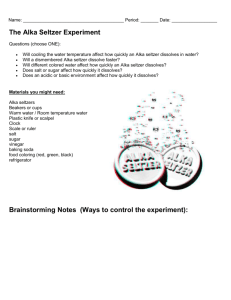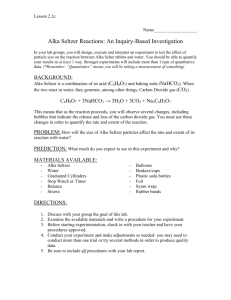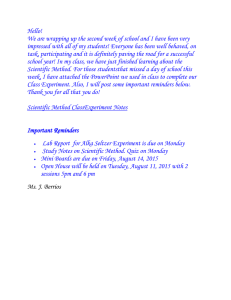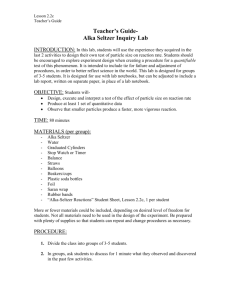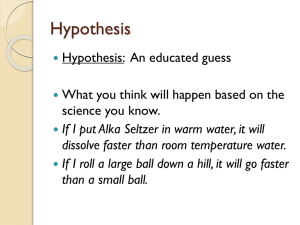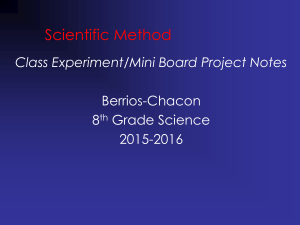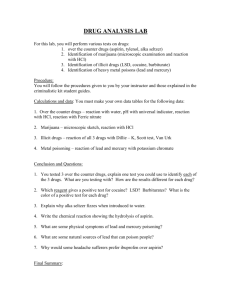Film Canister
advertisement
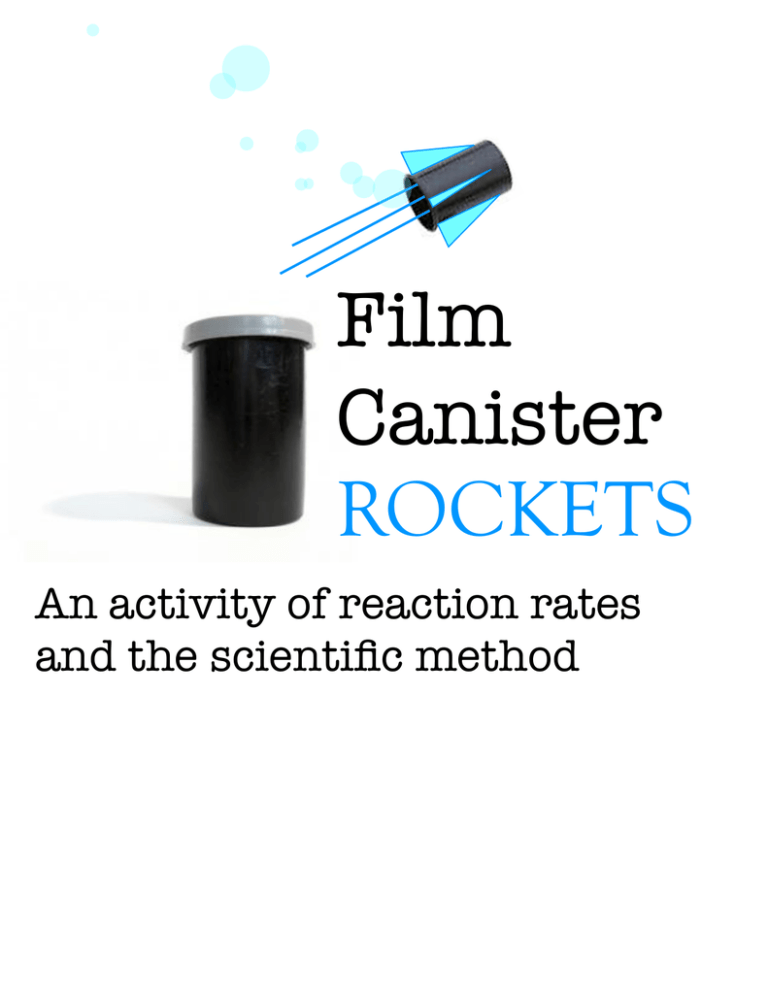
Film Canister ROCKETS An activity of reaction rates and the scientific method Developed by: Elisabeth Mills, UCLA NSF GK-12 Fellow Title of Lesson: Film Canister Rockets Grade level: 8th Grade Subject(s): Investigation and Experimentation, Chemical reaction rates Summary: Students will create alka-seltzer rockets using alka seltzer and film canisters in water, and design an experiment to test how changing a particular variable will change the rate of the alka seltzer/water reaction. Notes: This activity is designed to be performed as a guided or structured inquiry. Time Required: 90 minutes Group Size: This activity was tested with 10 groups of 3-4 students, supervised in a 20:1 student/teacher ratio. Materials: • 10 film canisters (1 per group) • Alka-Seltzer tablets • Stopwatches • Investigation Planning sheet (1 per group at minimum, 1 per student is best) • Student data chart (1 per group at minimum, 1 per student is best) • Ice water • Warm water from hotplate or electric kettle • Vinegar • Electric balance to mass the alka seltzer tablets • Graduated cylinders • Mortar and Pestle sets (or a hammer and ziploc bags) • Thermometers • Mop/sponges for cleanup Cost to Implement: $5-10 for film canisters (you can find them on ebay, they are reusable) and $10 for 72 alka seltzer tablets (about 7 per group, though 4 is sufficient) Other materials should already be available in classroom laboratory supplies. Learning Goals: The goals of this lesson are for students to learn the concepts and gain experience in the skills described below: • Practice forming scientific questions • Practice planning and conducting an investigation • Practice identifying and controlling variables in an investigation • Practice displaying data in charts and graphs • Know that the rate of a chemical reaction can be controlled by changing quantities such as the temperature, concentration, and ratio of reactants. Safety Issues: Students should wear goggles to prevent eye injury from film canister lids which may become projectiles. As this activity is also messy, students can choose to wear aprons or other protective clothing. Introduction (~30 minutes): Before the start of this activity, it would be good to provide a reminder for the students of how to identify manipulated (independent) variables, responding (dependent) variables, and fixed or controlled parameters. To begin this activity, demonstrate to the students a film canister rocket in action, and have students form questions. To help students identify variables, show them that you are measuring the following things as you assemble the rocket: • The volume of the water put into the container • The temperature of the water put in the container • The mass of the alka seltzer added to the container • The time it takes the reaction to occur (the top pops) Assemble the rocket by opening the canister, filling the canister with water, adding an alka seltzer, and quickly closing the lid. Place the canister right-side-up on a covered surface and in about ten seconds, the lid will pop or shoot off of the canister. Ask students to form questions about the demonstration, and how they could investigate it further. Have students share their questions, and transition from their questions to having them come up with a list of all possible variables they could change (Examples include temperature, amount of alka seltzer, the size of the container, how much you shake it, and how the alka seltzer is crushed) Groups can then investigate a variable of their choice, or each group can be assigned a variable to investigate. You should emphasize to the groups the importance of changing only one variable, the manipulated or independent variable, and leaving all other parameters fixed. Procedure for Investigation (~40 minutes): Once the groups are at their stations, they should fill out an Investigation Planning Sheet (attached below). When the instructor reviews this and finds it to be complete (students have a fully formed hypothesis, and a plan for how they will both change their manipulated variable and keep the others fixed) then the group is given their alka seltzer to begin investigating. Students should record the data from their investigations on their Student Data Collection Sheet (attached below). Different experiments will require different equipment. This lab was implemented with each group investigating one variable, with multile different stations set up for this purpose. The following equipment was at every station: • • • • • One film canister with lid Newspaper to cover the lab surface A beaker of room temperature water A graduated cylinder to measure the water A stopwatch This equipment is sufficient to investigate changing the following variables: the number of alka seltzer, the amount of water, the number of pieces one alka seltzer is broken into, and the amount of shaking the film canister undergoes. To investigate the changing the water temperature, groups will also need ice water, an electric kettle (or hot plate), and a thermometer. To investigate the effects of crushing the alka seltzer tablet, students will need a mortar and pestle (or just a ziploc bag and hammer) was well as optionally an electric balance to determine the amount of alka seltzer to add by its mass. To investigate the effects of pH, students will need vinegar and/or baking soda to add to the water in which the alka seltzer is involved. Students can either measure the quantity they add, or use universal indicator paper to measure the pH. Closure (~20 minutes): After students have recorded at least three trials, and students have used their alka seltzer allotment, groups should be instructed to clean their lab stations and discuss whether or not the data they collected agrees with their hypothesis. Groups can then present the following information to the entire class: • The manipulated (independent) variable they investigated • Their hypothesis • Whether or not their data supported their hypothesis This information could be recorded on the board so that students can compare results from different groups. Finally, having listened to all of the groups present, students can be asked how they would change all of these variables in order to make the fastest reaction. If there are sufficient time and materials, students could be given time to attempt to make the fastest reaction, or the students could give the instructor directions to demonstrate the fastest reaction in front of the entire class. Adapted from: ‘Investigating Reaction Rates Lesson Plan’ www.schools.utah.gov/curr/sci/GIST/Investigating%20Reaction%20Rates.pdf References: Wiggins, G. P., & McTighe, J. 2005. Understanding by design. (Association for Supervision and Curriculum Development) Bransford, J.D., Brown, A.L., and Cocking, R.R., Editors. How People Learn: Brain, Mind, Experience and School. Washington, DC: National Academy Press, 2000. CA Science Standards addressed: 9a: “Plan and conduct a scientific investigation to test a hypothesis.” 9c: “Distinguish between variable and controlled parameters in a test.” 9e: “Construct appropriate graphs from data and develop quantitative statements about relationships between variables” 5a: “Students know reactant atoms and molecules interact to form products with different chemical properties ” 5e: “Students know how to determine whether a solution is acidic, basic, or neutral ” 9g: “Distinguish between linear and nonlinear relationships on a graph of data” 9d: “Recognize the slope of the linear graph is the constant in the relationship y = kx and apply this principle in interpreting graphs constructed from data.” Attached Handouts: Investigation Planning Sheet What is your groupʼs prediction, or hypothesis, for how the reaction time will change as you change your manipulated variable? How will you make sure that in your experiment, only your manipulated variable changes between trials? Plan for testing your hypothesis that _________________________________ Step 1 Step 2 Step 3 Additional Steps: Student Data Collection Sheet Group Members: Fixed or Controlled Parameters: Variables such as temperature, volume of water, or amount of alka seltzer, which you are NOT changing during this experiment Fixed parameter: Value: Fixed parameter: Value: Fixed parameter: Value: In the table below, record the results of at least 3 trials you conduct by changing the value of your variable. (Example: Increase the temperature by about ten degrees each trial.) MEASUREMENTS TRIALS Manipulated Variable: Responding Variable: Reaction Time Unit: Unit: Trial #1 Trial #2 Trial #3 Does the data support your hypothesis? Why?
